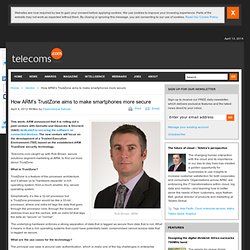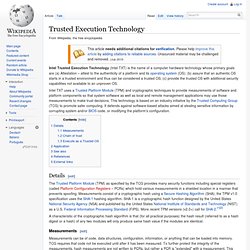

Mobile device security: the insider’s guide. Opinions and tips from the world-leading experts. Security/Architecture. This page includes all references to MeeGo Security Architecture content. This architecture is the result of the work of many different people. Thanks go to all of the MSSF Architecture Team. For The Reader The following document contains the overview description of Mobile Simplified Security Framework (MSSF) for the MeeGo.com release. MSSF is the basis of the MeeGo Security Architecture and will be delivered with MeeGo starting with the 1.2 release. Abstract The purpose of the Mobile Simplified Security Framework (MSSF), in the MeeGo platform, is to protect the owner of a MeeGo-powered platform from getting their personal data and passwords stolen and used for malicious purposes, to prevent malware from misusing the device, to prevent the user from accidentally breaking the device software, and to make the platform meet the needs of software that requires a safe execution environment.
TI OMAP4 First to be Awarded Netflix HD DRM Certification. Last week, TI Invited me out to their Dallas, Texas headquarters as part of an editors day. There they showed and talked about a number of exciting projects, including their WiLink combo WLAN, GPS, BT, and FM solutions, MSP430 microprocessors, their C66x multicore DSP, and of course more information on OMAP5.
If I had to pick a highlight however, it was being first to see Netflix HD playing back on a real live Android 2.3 device, in this case TI's Blaze development platform with an OMAP4430 SoC inside. Back when Netflix brought an official playback client to Android, modders were quick to discover that playback could be enabled on unapproved devices simply by modifying build.prop. What it boiled down to was that you could enable Netflix playback on unapproved devices merely by masquerading as an approved one. Further, the list of approved devices didn't clearly delineate any specific SoC. The second level is for HD content, Netflix's 'premium' level. How ARM’s TrustZone aims to make smartphones more secure. Rob Brown, ARM This week, ARM announced that it is rolling out a joint venture with Gemalto and Giesecke & Devrient (G&D) dedicated to securing the software on connected devices.

The new venture will focus on the development of a Trusted Execution Environment (TEE) based on the established ARM TrustZone security technology. Telecoms.com caught up with Rob Brown, secure solutions segment marketing at ARM, to find out more about TrustZone. What is TrustZone? TrustZone is a feature of the processor architecture, and it allows us to “hardware-separate” a rich operating system, from a much smaller, tiny, secure operating system. Simplistically, it’s like a 32-bit processor but a TrustZone processor would be like a 33-bit processor, where one extra bit tags the data that goes through the processor core, through the buses and address lines and the caches, with an extra bit that tags the data as “secure” or “normal”.
Www.intel.com/technology/security/downloads/arch-overview.pdf. Malware Protection with Intel® Trusted Execution Technology. Trusted Boot. Enhanced Data Protection with Hardware-Assisted Security. Trusted Execution Technology. Intel Trusted Execution Technology (Intel TXT) is the name of a computer hardware technology whose primary goals are (a) Attestation – attest to the authenticity of a platform and its operating system (OS); (b) assure that an authentic OS starts in a trusted environment and thus can be considered a trusted OS; (c) provide the trusted OS with additional security capabilities not available to an unproven OS.

Intel TXT uses a Trusted Platform Module (TPM) and cryptographic techniques to provide measurements of software and platform components so that system software as well as local and remote management applications may use those measurements to make trust decisions. This technology is based on an industry initiative by the Trusted Computing Group (TCG) to promote safer computing. It defends against software-based attacks aimed at stealing sensitive information by corrupting system and/or BIOS code, or modifying the platform's configuration. Details[edit] Measurements[edit] Application[edit]